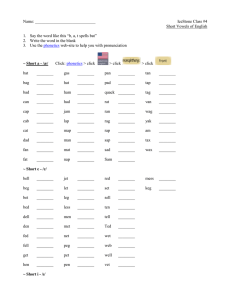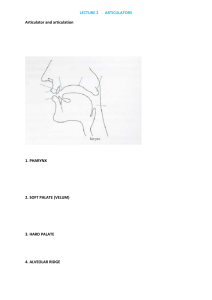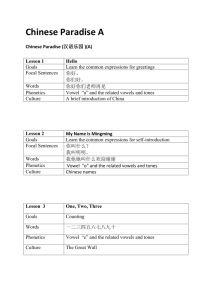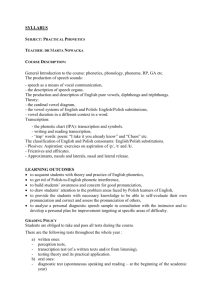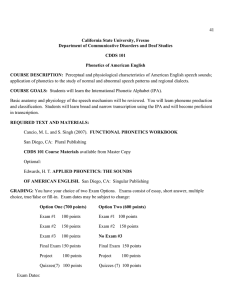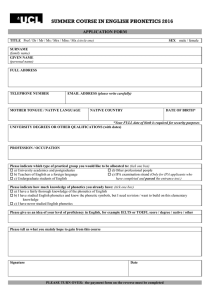DISCOVERING PHONETICS: LEARNING THROUGH FIELDWORK Patricia Ashby, Alison Manamperi, Matt Youens
advertisement
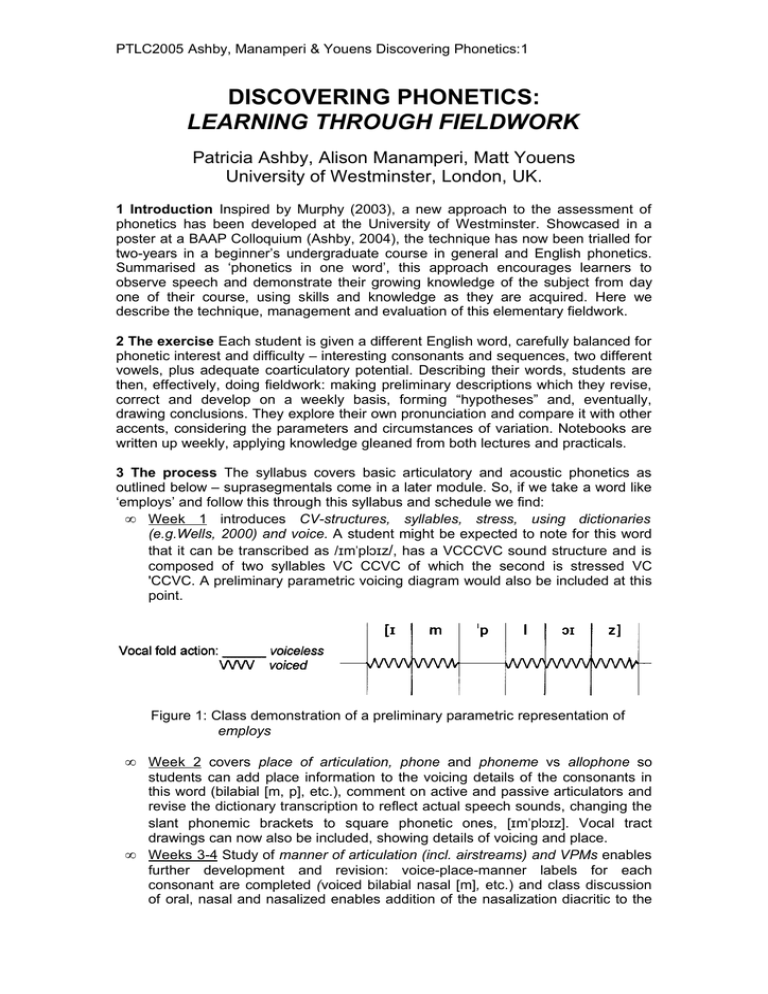
PTLC2005 Ashby, Manamperi & Youens Discovering Phonetics:1 DISCOVERING PHONETICS: LEARNING THROUGH FIELDWORK Patricia Ashby, Alison Manamperi, Matt Youens University of Westminster, London, UK. 1 Introduction Inspired by Murphy (2003), a new approach to the assessment of phonetics has been developed at the University of Westminster. Showcased in a poster at a BAAP Colloquium (Ashby, 2004), the technique has now been trialled for two-years in a beginner’s undergraduate course in general and English phonetics. Summarised as ‘phonetics in one word’, this approach encourages learners to observe speech and demonstrate their growing knowledge of the subject from day one of their course, using skills and knowledge as they are acquired. Here we describe the technique, management and evaluation of this elementary fieldwork. 2 The exercise Each student is given a different English word, carefully balanced for phonetic interest and difficulty – interesting consonants and sequences, two different vowels, plus adequate coarticulatory potential. Describing their words, students are then, effectively, doing fieldwork: making preliminary descriptions which they revise, correct and develop on a weekly basis, forming “hypotheses” and, eventually, drawing conclusions. They explore their own pronunciation and compare it with other accents, considering the parameters and circumstances of variation. Notebooks are written up weekly, applying knowledge gleaned from both lectures and practicals. 3 The process The syllabus covers basic articulatory and acoustic phonetics as outlined below – suprasegmentals come in a later module. So, if we take a word like ‘employs’ and follow this through this syllabus and schedule we find: • Week 1 introduces CV-structures, syllables, stress, using dictionaries (e.g.Wells, 2000) and voice. A student might be expected to note for this word that it can be transcribed as /ɪmˈplɔɪz/, has a VCCCVC sound structure and is composed of two syllables VC CCVC of which the second is stressed VC 'CCVC. A preliminary parametric voicing diagram would also be included at this point. Figure 1: Class demonstration of a preliminary parametric representation of employs • • Week 2 covers place of articulation, phone and phoneme vs allophone so students can add place information to the voicing details of the consonants in this word (bilabial [m, p], etc.), comment on active and passive articulators and revise the dictionary transcription to reflect actual speech sounds, changing the slant phonemic brackets to square phonetic ones, [ɪmˈplɔɪz]. Vocal tract drawings can now also be included, showing details of voicing and place. Weeks 3-4 Study of manner of articulation (incl. airstreams) and VPMs enables further development and revision: voice-place-manner labels for each consonant are completed (voiced bilabial nasal [m], etc.) and class discussion of oral, nasal and nasalized enables addition of the nasalization diacritic to the PTLC2005 Ashby, Manamperi & Youens Discovering Phonetics:2 transcribed form, [ɪ̃mˈplɔɪz]. Velum action information can also be added to the parametric representation and airflow arrows to the vocal tract drawings. Figure 2: Students’ vocal tract drawings after 3-4 weeks of study • Week 5 study of Cardinal Vowels & vowel description including simple vs complex, long vs short, plus vowel diagrams enables inclusion of descriptive vowel labels in the notebook (a short, simple, centralized front, close-mid, neutral vowel and a long complex back open-mid rounded gliding towards centralized front close-mid neutral vowel) plus an appropriate vowel diagram. Figure 3: A student’s vowel diagram for [ɪ] and [ɔɪ] at week 6. • • • Week 6: In week 6 speech acoustics, which has been touched on weekly, is revised and consolidated. Although not compulsory, some students downloaded the freely available speech analysis programmes such as Wasp or Praat (introduced in class) and included waveforms and spectrographic images in their notebooks. This was very exciting for the teacher – indicative, perhaps, of the amount of involvement and interest this exercise can generate. One student, without access to computing facilities, even drew a detailed spectrographic sketch of her word with a full page of detailed annotations (see Fig. 4 below). Weeks 7-8: The course now moves from general phonetics to look in more detail at the phonetics of English, beginning with major allophones of English vowels. This enables further revision of the narrow transcription to incorporate falling prominence in the diphthong and final obstruent devoicing: [ɪ̃mˈplɔɪ̯zz̥]. Discussion would highlight the absence of any clipping and, ideally, there would now be a brief articulatory description of each vowel. Further revision of the parametric diagram to show devoicing of the final sound might also occur here. Weeks 9-10: English obstruents (major allophones: VOT and plosives, lenis obstruent devoicing, place assimilations, glottalization, slit/grooved, etc.) Long VOT following [p]-release will be picked up here together with the resultant devoicing of the [l]-sound will be included in a further revision of the transcribed PTLC2005 Ashby, Manamperi & Youens Discovering Phonetics:3 Figure 4: A student’s spectrographic ‘sketch’ of the word stamping (week 6). form, giving something like [ɪ̃mˈpl̥lɔɪ̯zz̥]. A brief articulatory account of the steady state of each obstruent will also be included at this point and one final revision of the parametric diagram to include the effect of the long VOT. • Weeks 11-12: Finally, study of English sonorants (major allophones, secondary articulations) will enable the account of the lateral to be brought up-to-date showing palatalization plus the accommodatory labialization of this sound before Figure 5:Class demonstration of a summative parametric diagram of employs the rounded vowel. This could be shown in the transcription which could become quite complicated and detailed (see Fig. 5 above, for example). Ideally, the notebook will then conclude with an articulatory account of each sonorant. PTLC2005 Ashby, Manamperi & Youens Discovering Phonetics:4 4 Management First trials in 2003-04 showed that a single final assessment was not enough. Not having to meet an immediate deadline lead many to put off writing up. Accordingly, in the second run in 2004-05, notebooks were taken in for marking twice: at week 6 and again at the end of the module. Written advice in the Course Pack was also enhanced, giving detailed weekly guidelines. (An interactive medium such as Blackboard or WebCT is ideally suited to this.) 5 Results Informally, students report that the experience of the notebook in the first semester not only facilitates initial mastery of the subject matter but also helps the second semester study of connected speech, especially with the exercise of articulatory description. It is, however, still rather too early to say whether the notebooks enhance student learning in the long term. 6 Conclusion In spite of the difficulty of the subject matter and the self-discipline required to keep notebooks up-to-date, we think this approach is proving successful (and even popular!). The strategy illuminates and concentrates the learning process from the student viewpoint and for the teacher, focuses the teaching process. Students report a sense of ownership and achievement. Giving the last words to the students, the following conclusions derive in the main from feedback in the University of Westminster’s module monitoring questionnaires: • the notebook ensured that no matter how complex or difficult the material was, you had to confront it and get to grips with it in order to be able to state clearly how far (if at all) and in what way that theory was evidenced in your word; • the need to keep the notebook up-to-date was a motivating factor; • the incremental nature of the exercise makes what would otherwise be a very large undertaking quite manageable – you probably do more work and learn more than you would if you had to write it all up at the end; • the word, whatever it is, provides an example with which you can become really familiar – this boosts confidence and offers a point of comparison with other examples that are put forward in class; • the notebooks offer valuable insight into the scope and depth of knowledge that has been acquired and many students express their extreme surprise at just how much can be said about a single short utterance, a single word; • watching the work grow and realising that you have been able to say all this is very encouraging. The one point that recurs in the students comments is the feeling that having to apply the knowledge while it is still fresh in their mind from a class really makes sure that they learn it – and they feel that that knowledge stays with them in a way in which information rote-learned for examination purposes, for example, seems not to. References Ashby, P. (2004) “Phonetics in one word: Learning through fieldwork.” Poster presented at the Colloquium of the British Association of Academic Phoneticians, Cambridge. Ashby, P. (2005) “Making phonetics attractive.” (Paper presented at the Subject Centre LTSN workshop: The Future of Phonetics.) Murphy, Lynne (2003) “Linguistics in a word.” (Paper presented at the Subject Centre LTSN workshop: Techniques and Resources for Teaching Linguistics.) Wells, J.C. (2000) The Longman Pronunciation Dictionary. London: Longman. New edition.
